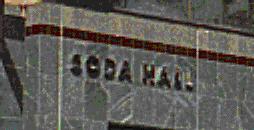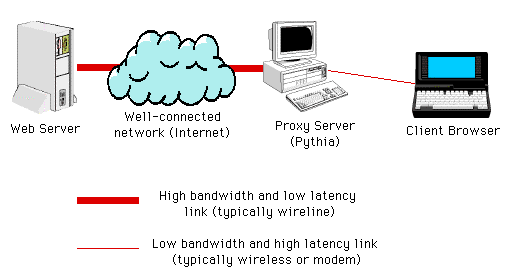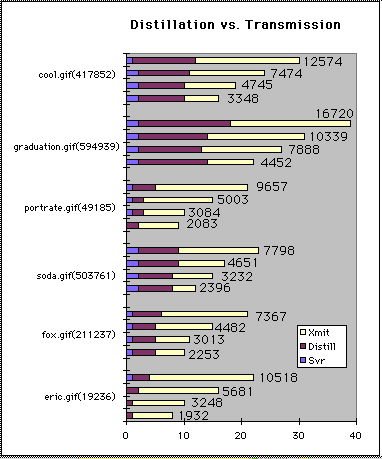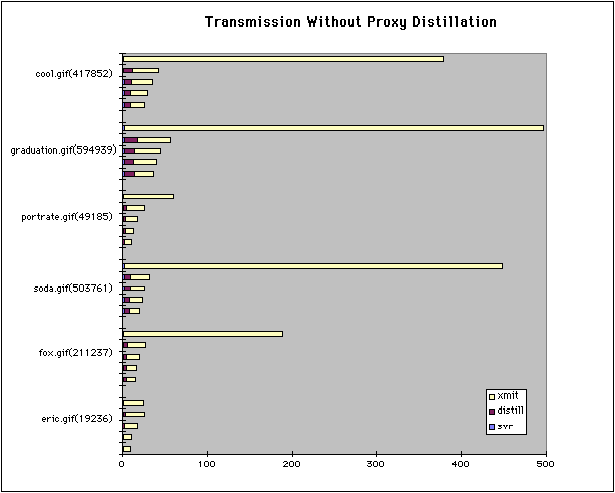 Reducing WWW Latency and Bandwidth
Requirements by Real-Time Distillation
Reducing WWW Latency and Bandwidth
Requirements by Real-Time Distillation



Journal reference: Computer Networks and ISDN Systems, Volume 28, issues 7–11, p. 1445.
 Reducing WWW Latency and Bandwidth
Requirements by Real-Time Distillation
Reducing WWW Latency and Bandwidth
Requirements by Real-Time DistillationSince there is no way to optimize a single page for delivery to both high-bandwidth and low-bandwidth clients, some sites, such as [Xinside] , offer multiple versions of pages (no graphics, minimal graphics, full graphics). Most sites, however, do not have the human resources or disk space to do this.
Clearly an automated mechanism for closing the bandwidth gap is needed. Several such mechanisms are currently deployed, but all are inadequate:
Our definition of distillation as lossy compression is independent of the specific encoding of the image. For example, GIF is a lossless image encoding format, but the distillation process throws away information in shrinking the image and quantizing its colormap.
As another example, a PostScript text document can be distilled by extracting the text corresponding to document content and analyzing the text corresponding to formatting information in order to glean clues about the document structure. These clues can be used to compose a "plaintext-plus" version of the document, in which, for example, chapter headings are in all caps and centered, subsection headings are set off by blank lines, etc. The distilled representation is impoverished with respect to the original document, but contains enough semantic information to be useful to the user. Adobe Systems' Distiller Pro package (not to be confused with our use of the term "distillation") performs a similar function, constructing a portable document format (PDF) file from a PostScript file.
Clearly, distillation techniques must be datatype-specific, because the specific properties of a document that can be exploited for semantic-preserving compression vary widely among data types. We say "type" as opposed to "subtype" (in the MIME sense), since, for example, the techniques used for image distillation apply equally well regardless of whether the source image is in GIF or JPEG format.
We use the term refinement to refer to the process of fetching some part (possibly all) of a source document at increased quality. We can define a refinement space for a given datatype, whose axes correspond to the properties of the datatype exploited by the corresponding distillation technique. For example, some obvious axes for still graphics are scale (as a fraction of the original) and color depth. The source image corresponds to the tuple <1,1,...,1> in refinement space. Distillation and refinement can then be thought of as parameterized mappings between points in refinement space. The example interface by which a user specifies a desired refinement is application-specific; for example, using a mouse to select a subregion of an image for zooming.
Refinement space for a given datatype may be discrete or continuous. For example, the pixel-dimension refinement axis is (nearly) continuous, but for distilling rich text, we may be able to identify only a relatively small fixed number of intermediate quality representations. For PostScript, these would likely consist of "plain text" (ASCII only with minimal formatting clues), structured rich text (such as PDF or HTML), and original PostScript.
 |
 |
| Distilled to 320x200 (17KB) | Refinement of writing on building (15KB) |
| Click here to see original image (503K GIF) |
Notice how distillation and refinement have been used to explicitly manage the limited bandwidth available to the user. The distilled image and refinement together occupy only a fraction of the size of the original. The total bandwidth required to transmit them is a fraction of what would have been required to transmit the original, which might have been too large to view on the user's screen anyway. The process of distilling the original to produce the smaller representation took about 6 seconds of wall clock time on a lightly loaded SPARC-20 workstation; the process of extracting the subregion from the original for refinement took less than 1 second.
| Device | CPU/MHz | Typ. bandwidth (bits/s) | Display size | Minimum xmit latency, 5K/50K/200K bytes |
| Apple Newton | ARM 610/20 | 2400 | 320x240, 1-bit | 0:17/2:50/11:20 |
| Sony MagicLink | Motorola 68340/20 | 14.4K | 480x320, 2-bit gray | 0:03/0:30/1:20 |
| Typical notebook PC | Intel or PPC/60-100 | 28.8K
wireline, 9600 cellular | 640x480 to 800x600, 8-bit color | 0:02/0:15/0:60 wireline, 0:04/0:42/2:48 cellular |
| Typical desktop PC | Intel or PPC/60-120 | 56K
ISDN, 10M Ethernet | 640x480 to 1024x768, 16-bit color | 0:01/0:07/0:29 |
Mosaic, Netscape, and other popular WWW browsers allow the user to designate a particular host as a proxy for HTTP requests. Rather than fetching a URL directly from the appropriate server, the fetch request is passed on to the proxy. The proxy obtains the document from the server on the client's behalf, and forwards it to the client. The proxy mechanism was originally included to allow users behind a corporate firewall to access the WWW via a proxy that had "one foot on either side" of the firewall. Our proxy, Pythia* , is intended to run near the logical boundary between well-connectedness and poorly-connectedness.
As a first-order approximation, if we take the majority of the wired Internet to be well-connected and consider a client using PPP or SLIP to be poorly-connected, Pythia can run anywhere inside the wired Internet. The architecture of a "proxied" WWW service is shown schematically in Figure 2.

Figure 2: Architecture of a "proxied" WWW service
The idea of placing a proxy at this boundary has also been explored in the LBX (Low Bandwidth X) project, on which the Berkeley InfoPad's [BBB+94] "split X" server is based. The idea of using a proxy to transcode data on the fly was discussed in [BMM95].
Pythia uses the model to meet user-specified bounds on inline image size (and therefore latency) while surfing the WWW. For example, suppose the user is using a 28.8 modem and has specified a maximum latency of 5 seconds per inline image, and Pythia encounters an inline image that is 40 Kbytes in size. The maximum traffic that can be carried in 5 seconds at 28.8Kbits/sec is about 5.6 Kbytes, so Pythia calculates the distillation parameters necessary to produce a representation of the image that is about 5.6 Kbytes in size. In practice, the bound on the image size will be tighter, since Pythia must account for the additional latency introduced by the distillation process itself.
The first graph (Figure 3) shows a breakdown of server fetch, distillation, and transmission times for a small sample of images found on Berkeley WWW servers, as transmitted to a client on a conventional 14.4 modem using PPP.
The unusually high transmit latencies for the small (3K) images reflect a highly loaded PPP gateway that typically adds up to .5 seconds each way per roundtrip; unfortunately, such performance is not unusual when using PPP-based ISP's.

Figure 3: Breakdown of server fetch, distillation and transmission times
for various images
The second graph (figure 4) shows the raw transmit latencies, including TCP and PPP-gateway overhead, for transmitting the undistilled originals of the above images to the client using the same modem connection. For reference, the bars in the above graph are also reproduced below. As the graph shows, the total perceived latency at the client is reduced by approximately an order of magnitude when Pythia is used, even though the distillation process takes measurable time.

Figure 4: Raw transmit latencies for the undistilled originals
To use Pythia, a user specifies Pythia's host and port as the HTTP Proxy in the Preferences dialog of most browsers, and fills out the profile form. Pages delivered by Pythia look like their "unproxied" counterparts, except that some of the inline images have been distilled. Bounding boxes of the original images are preserved, to accommodate pages where the layout has been fine-tuned for viewing on a particular browser.
The user can request a refinement of a distilled image by following an HTTP link next to each distilled image. Depending on the user's profile, the original image will be fetched and displayed on a page by itself, or it will be refined "in place" and the current page re-rendered around it. Pythia adds these "fetch refinement" links to the HTML text on the fly, as described in the next section.
For example, here is a portion of a web page before refinement, and the same page after the user has refined the inline image.
If image dimension hints are supplied in the source page's IMG tag, Pythia passes them on to the client; however, Pythia cannot add dimension hints itself, since at the time it sees the referencing HTML tag, it cannot know what the actual image dimensions will be without prefetching part of the image, which might add unacceptable latency. We are experimenting with this tradeoff to determine which method will provide a higher perceived quality of service to the user.Pythia also translates PostScript to HTML, using software developed in part by DEC SRC [McJ]. This distillation typically results in a reduction of 5-7x for PostScript text, and has the additional advantage that the text can be rendered on clients for which PostScript previewing is awkward, such as PC's running Windows. This is an example of distillation that provides both of the orthogonal benefits mentioned previously: content size reduction and optimization for rendering on the target display.
Distillers can run on the same physical machine as Pythia or on different machines. Pythia keeps track of which distillers are running on which machines, and attempts to do simple load balancing across them. The Berkeley Network of Workstations (NOW) project [ACP+95] has provided a job-queue interface for harvesting idle cycles on machines in the NOW; we are retrofitting Pythia to use this mechanism to spawn and destroy distillers dynamically as NOW resource levels fluctuate.
Since Pythia can farm out distillation work to other workstations, the cycles required to perform distillation for clients do not constitute a performance bottleneck. Instead, like HTTP servers, the limiting factor is the single pipe in and out of the "front end" that receives HTTP requests (i.e. the process listening on the TCP port designated as the HTTP Proxy). The current implementation of Pythia is in unoptimized Perl; translation to C should increase the number of requests that can be handled by the front end per unit time. Current usage patterns indicate that this metric will not be a bottleneck when only a few users are served by a single front end. We are planning joint work with the Berkeley Office of Telecommunications Services, which provides dial-up PPP and SLIP services to about 6,000 subscribers on the Berkeley campus, to allow them to provide web proxy service as part of their subscription package. This experiment will stress Pythia and allow us to explore various strategies for scaling the front-end using a "magic router" based on fast IP packet interposition [And95] .
Pythia currently performs a Unix fork() to handle each new HTTP request. It is well known that the latency of this operation is substantial [Ous90] . Future versions of Pythia will be multithreaded rather than relying on process-level parallelism, and idle worker threads rather than forked processes will handle multiple incoming requests.
The bandwidth of the client connection currently must be filled in on the User Preferences HTML form. Pythia takes the user's word for this quantity, rather than attempting to measure the quality of the connection directly (e.g., by estimating the latency between the transmission of HTML text to the client and reception of an HTTP request for an embedded image). The short lifetimes of HTTP TCP connections and the overhead of TCP slow start make it difficult to measure end-to-end bandwidth accurately.
Pythia cannot hide server-to-proxy latency, though it can mitigate it by distillation and caching. Pythia's distillation estimates are based solely on the proxy-to-client bandwidth stated by each user.
Pythia is fault-tolerant with respect to distillers: it will reap distillers that are killed due to NOW load balancing and will continue to function with degraded performance. If Pythia's front-end crashes, however, the user will see an error that the proxy has stopped accepting connections. We currently do not have a fault-tolerance strategy for the front-end.
Because Pythia works by munging URL's, it may cause cache inconsistency at the client. For example, after a user stops using Pythia, that user's cache will contain some entries whose keys (URL's) are the Pythia-modified URL's rather than the original source URL's. Flushing the client cache fixes this problem at significant inconvenience to the user. URL munging is necessary because HTTP provides no way for Pythia to maintain "session state" describing which inlines on a given page have been distilled and which have not. To circumvent this limitation, Pythia encodes this information into the URL's passed back and forth between client and proxy. HTTP-NG will include some notion of session control, which should allow us to maintain the appropriate state without resorting to URL-munging.
As part of our wireless and mobile computing effort, we are developing a variant of Pythia with a richer client API for building network-adaptive applications. This API will allow negotiation of a wider variety of datatypes, an environment in which agents can run, and distillation services for continuous-media streams such as MPEG (an implemented example is [AMZ95]).
[AMZ95] Elan Amir, Steve McCanne, Hui Zhang. An Application-Level Video Gateway . Proc. ACM Multimedia 95, San Francisco, Nov. 1995.
[And95] Eric Anderson. An Application of Fast Packet Interposing: The Magic Router. http://www.cs.berkeley.edu/~eanders/262/.
[ASA+95] Marc Abrams et al. Caching Proxies: Limitations and Potentials. Fourth International WWW Conference, Boston, MA, Dec. 1995.
[Bar95] Joel F. Bartlett. Experience with a Wireless World Wide Web Client. IEEE COMPCON 95, San Francisco, March 1995.
[BCS] Bandwidth Conservation Society home page. http://www.infohiway.com/faster/
[BMM95] Charles Brooks, Murray S. Mazer, Scott Meeks, Jim Miller. Application-Specific Proxy Servers as HTTP Stream Transducers. Fourth International World Wide Web Conference, Boston, MA, Dec. 1995. http://www.w3.org/pub/Conferences/WWW4/Papers/56/.
[Gla93] Steven Glassman. A Caching Relay for the World Wide Web. Computer Networks and ISDN Systems 27(2), Nov. 1994. Also appeared in Proc. First Int'l World Wide Web Conference.
[LA94] A. Luotonen and K. Altis. World-Wide Web Proxies. http://www.w3.org/hypertext/WWW/Proxies/.
[McJ] Paul McJones, personal communication.
[MLB95] Radhika Malpani, Jacob Lorch, David Berger. Making World Wide Web Caching Servers Cooperate. Fourth International World Wide Web Conference, Boston, MA, Dec. 1995.
[NPS95] Brian D. Noble, Morgan Price, and M. Satyanarayanan. A Programming Interface for Application-Aware Adaptation in Mobile Computing. 1995 Mobile and Location-Independent Computing Symposium.
[Ous90] John K. Ousterhout. Why Aren't Operating Systems Getting Faster As Fast As Hardware? USENIX Summer Conference Proceedings, June 1990.
[PG93] Venkata Padmanabhan and Jeffrey C. Mogul. Improving HTTP Latency. Computer Networks and ISDN Systems 28(1), Dec. 1995. http://www.cs.berkeley.edu/~padmanab/papers/www_fall94.ps
[Xinside] X Inside Inc. home page. http://www.xinside.com
Eric A. Brewer is an Assistant Professor of Computer Science at U.C. Berkeley, and received his PhD in CS from MIT in 1994. Interests include mobile and wireless computing (the InfoPad and Daedalus projects); scalable servers (the NOW and Inktomi projects); and application- and system-level security (the ISAAC project and Netscape security holes). Previous work includes multiprocessor-network soft-ware and topologies (Strata, metabutterflies), high-performance multiprocessor simulation (Proteus).